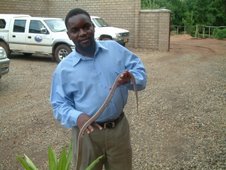
Nalikukuti, One of Malawi's popular snakes
by Hastings Maloya
A relatively small but long snake. Very common in most parts of Malawi. This could be one of the snakes that most people have managed to see or heard of in and around their localities. It is very common but has caused minimum harm on people.
This is a vine snake , which is also known as a twig snake, or sometimes it is referred to as a bird snake. It is locally known as nalikukuti or kalikukuti but its scientific name, which is mostly used by scientists and biologists is Thelotornis capensis.
An adult vine snake would averagely be 80cm long but most of them are 1.2m long. According to records, the longest so far was recorded in Mozambique and was 1.47m long. The vine snake is always thin and looks small despite its age. It does not have a specific colour because mostly it resembles the colour of the environment in which it is found. The snake is cryptically coloured or camouflaged especially when it is motionless in a tree or on a shrub. It resembles tree branches or twigs (hence the name twig snake).
Despite its size, a vine can swallow something two or three times its size. Though timid and tiring, the vine snake will inflate its neck to display its anger when threatened. It actively hunts for food during the day. It takes time to catch its prey but when it does, no matter how long it would take to swallow it, it would. It is a slow eater but with a very flexible neck that allows big prey to pass. The vine mainly eats lizards, chameleons and frogs. Snakes and birds are also taken on occasion. This snake usually strikes from above and often swallows its prey. It spits and the venom takes control of the prey!
The difference between a male and a female is not enormous. A male has much longer tails than the females and women (females) are more heavy-bodied than males. If not disturbed, this snake can stay motionless on the same spot for four days. In most cases, the vine snake changes position or moves from wherever it is when it is disturbed. Just as is the case with most snakes, the vine snake does not move in pairs nor is it seen with its off springs. This snake is a beauty to watch for those that have a liking for snakes.
The vine snake has a coloured long tongue, which mostly is bright yellow to orange-red but black to its tip. As is the case with any other snake, the vine has a forked tongue. And just like any other snake, the vine uses its tongue for smell and not taste as is the case with other animals. Every snake uses its tongue to smell and look for its prey. A snake does not need a feel of taste because it enjoys what it normally eats. Be assured that the forked tongue of a snake can not harm or sting in any way and is used only for smelling.
As stated above, Thelotornis capensis is mostly found in trees and shrubs in lowland forest to moist savanna and arid savannas. In other words, the vine snake is predominantly found in the southern Africa region and mainly in countries like Malawi, Mozambique, Zimbabwe, Namibia and South Africa. Among the countries, South Africa has the most population. This could be because most South Africans love keeping snakes and they are serious on regulations about conservation of wild animals.
These snakes are not naturally found in Europe. Izi ndi zathu zathu za ku Africa. Of course Sweden has some but are all exported from Southern Africa
For the sake of interest, and to be sure you have seen a vine snake, look out for:
• Lance-shaped head with keyhole-shaped pupil
• Superbly camouflaged as a branch or twig
• Inflates the neck showing the skin colours when comforted
• Spends most of its life in trees and shrubs
• Top of the head is green or blue-green
• Red and black tongue is held out when threatened
Most people in Malawi are yet to develop the liking for snakes. As such very few individuals keep snakes. And the vine snake has not been fashionable among snake keepers.








1 comment:
I had heard that the sound of the flute is not what makes the snake moves like that since a snake is deaf, so the ritual consists of something else. The snake is said to have special properties like fixing the problem of erectile dysfunction, but the medication of Viagra Online is a thousand times better.
Post a Comment